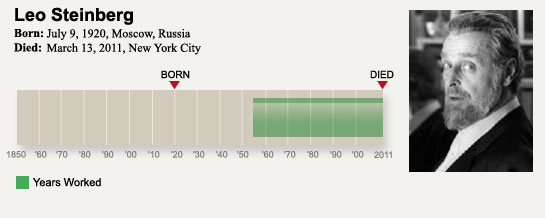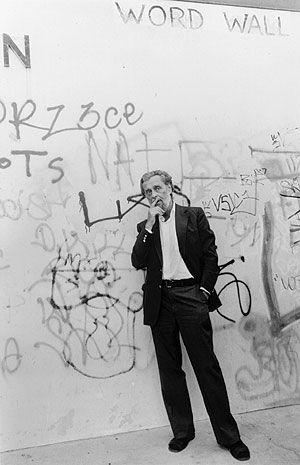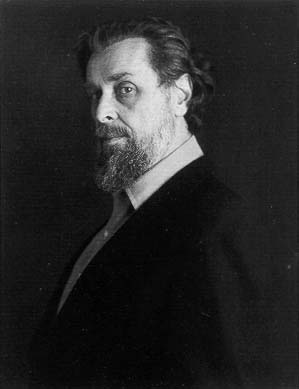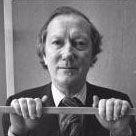
Summary of Leo Steinberg
Leo Steinberg is one the 20th century's foremost historians and scholars on the works of Michelangelo, Leonardo and other Italian Renaissance artists. Throughout his career, Steinberg has paid particularly close attention to the depiction of Christ in art, and in the process caused much controversy and debate. In addition to his scholarly work of Renaissance art, Steinberg is also a significant authority on 20th-century modern art, including the paintings and sculptures of Picasso, Jasper Johns's Flag series, and Willem de Kooning's Woman series. His scholarly work has consistently placed art and artists in a historical context, yet he is known for his less than formal approach to criticism by often using a first-person narrative in his essays. This style has personalized art criticism, making it experiential for readers and museumgoers. Key Ideas / Information
- Steinberg famously said that "Anything anybody can do, painting does better..", indicating his profound love and reverence for the visual arts' ability to not just reflect life, but to become life itself.
- Steinberg believed that the greatest difference between modern painting and that of the Old Masters was almost entirely to do with the viewer's subjective experience of the artwork.
- Steinberg defied the assertion made by fellow critic Harold Rosenberg that the Abstract Expressionists were "Action Painters," who formed spontaneous events on the canvas. He believed that artists like de Kooning and Kline were far more deliberate in their efforts, and were far more concerned with creating good art than simply living on the canvas.
Childhood
Born in Moscow to German-Jewish parents, the family later moved to Berlin, where Steinberg spent most of his childhood, between the years 1923 and 1933. Early years
From 1936-40, Steinberg studied sculpture and painting at the Slade School in London. After World War II, he emigrated to New York City and began work as a freelance writer and German-English translator. Steinberg's career in the New York art world was launched when, in 1951, he delivered a lecture series at the 92nd Street Y entitled An Introduction to Art and Practical Esthetics. He has said the purpose of these talks was "to provoke an unprejudiced response to various and contradictory art forms."
As a freelance writer in 1950s, his essays found a home in many of the avant-garde, politically leftist publications that were popular at the time, including Partisan Review and Artforum. In particular, Steinberg was quite taken with the art works of Jackson Pollock and Jasper Johns, who were both causing quite a bit of controversy in the New York art world.

Middle years
In 1955, Steinberg began writing a number of insightful reviews in Arts magazine about contemporary modern artists. He wrote for the very first Jackson Pollock retrospective at the Sidney Janis Gallery in New York, Willem de Kooning's Woman paintings at the Martha Jackson Gallery, and for the sculptor Julio Gonzalez's retrospective at MoMA, the first U.S. exhibition of metal sculpture work. In 1960, he earned his Ph.D. in art history from the Institute of Fine Arts at New York University. Steinberg taught art history and life drawing at Hunter College, the City University of New York (CUNY), from 1962 until 1975. While at Hunter, Steinberg was instrumental in developing the curriculum for CUNY's graduate program in art history, which was launched in 1971.
Although best known for his scholarly work on Renaissance art, Steinberg wrote two career-defining essays in 1972 on modern art. The first was an in-depth examination of Picasso's famous 1907 portrait Les Demoiselles d' Avignon, entitled The Philosophical Brothel, and the second was a harsh critique of formalist art criticism, entitled Reflections on the State of Art Criticism.
Since the 1970s, Steinberg has held a steady stream of professorships and lecturing posts at various universities, including Stanford, Berkeley, Princeton, Columbia and Harvard. He has also lectured extensively at museums and galleries around the country.
In 1983, Steinberg became the first ever art critic to receive the Award in Literature from the American Academy and Institute for Arts and Letters.
Later years
After working as a Visiting Professor of Art History at the University of Texas, in 2002 Steinberg donated his private collection of 3,200 prints to the University's College of Fine Arts, valued at approximately $3.5 million. The collection includes prints by Rembrandt, Matisse, Goya, Picasso and Johns, although the majority comprises prints from 16th-18th century artists such as Michelangelo and Agostino Veneziano. Legacy
As an historian of both Renaissance and Modern art, Steinberg has covered a broad range of subjects in the art world. His scrutiny and eye for detail established Steinberg as a foremost authority on some of history's most prized paintings and prints, dating back nearly a half millennia. He studied the most minute of details in paintings because he believed, above all else, that great artists were master tradesmen who applied time-tested techniques to their canvases, with slow and deliberate action. Despite Steinberg's broad range of topics and thirst for historical context, he is anything but a traditional formalist. In fact, his criticism has been something of a maverick for art historians and critics alike. MOST IMPORTANT ESSAYS:
Contemporary Art and the Plight of Its Public
Based on lectures given at the Museum of Modern Art, New York, 1960
Appeared in Harper's Magazine, March 1962
In this essay, Steinberg attempted to figure out just who "the public" is when it comes to art. It's a term used ubiquitously by artists, dealers and curators, but Steinberg reveals that obviously, "we don't know who these people are."
He begins by telling the story of when Matisse unveiled his painting The Joy of Life in 1906. Now considered a breakthrough work of Modern art, it was initially panned as the visual ramblings of a man who had "gone to the dogs." A year later, Picasso unveiled his Les Demoiselles d' Avignon, and this time it was Matisse who railed against the artist, who made what would later be considered yet another great breakthrough for Modern art.
Steinberg points out that whenever a great artist is kept out of the establishment, it's by other artists, citing that Manet and Courbet were at one time scoffed at by the Impressionists and Post-Impressionists. Yet it is these very artists who are "the public." Matisse, Steinberg points out, is a member of Picasso's public.
The "plight" to which Steinberg refers is, "the shock of discomfort or bewilderment or the anger or the boredom which some people always feel, and all people sometimes feel, when confronted with an unfamiliar style."
Other Criteria
Based on lecture given at the Museum of Modern Art, New York, 1968
Excerpt of lecture appeared in Artforum, March 1972
Throughout his vast body of writing, Steinberg is constantly pointing out similar themes used by artists of different eras and movements from the Renaissance to the 20th century. However, strangely enough, there is a constantly-shifting criteria for how people view art, and determine whether it is socially relevant or not. The same goes for the people who become artists. The type of person who becomes an artist in the Renaissance is not necessarily the same in the 19th or 20th century.
In Other Criteria, Steinberg examines the critical styles and perspectives of two of the 20th century's most influential critics, Clement Greenberg and Harold Rosenberg. He first cites Rosenberg's words about Action Painting being, "no longer concerned with producing a certain kind of object..but with living on the canvas." Steinberg's reaction is blunt, "It is important to remember that these statements were never true."
Steinberg is more forgiving of Greenberg theoretical style, but no less critical of his approach, "Whatever else one may think of Greenberg's construction, its overwhelming effect is to put all painting in series." He is also skeptical of Greenberg's take on Modern art, from Manet to Kelly, as one long series of categorization.
Steinberg also takes a long hard look at the issue of "flatness" in painting, paying close attention to the works of Kenneth Noland and Morris Louis. He cites a certain speed and efficiency to these paintings that is reminiscent of Jackson Pollock, who much like the later Color-Field and Hard-edge painters, called attention to the act of painting in the painting itself. "It demands consideration of subject and content," writes Steinberg, "and, above all, of how the artist's pictorial surface tilts into the space of the viewer's imagination."
THEORY:
Intro to Leo Steinberg's Theory
As a writer and historian, Steinberg knows the dangers of being too analytical or formal in the critique of any artist or movement. In his essay Other Criteria he writes, "Modern art always projects itself into a twilight zone where no values are fixed. It is always born in anxiety, at least since Cézanne." Steinberg's view of art - whatever the era or movement - is always a historical one, grounded in context. When Steinberg considers the merits of an artwork, he tries to understand the artist's intent, his own reaction to the piece and perhaps most importantly, the physical make-up of a work of art. Steinberg takes his readers on a journey inside each painting, so that they may try to understand what the artist is attempting on the canvas, rather than focus on the intended reaction. Steinberg on Pablo Picasso
The sheer breadth of Pablo Picasso's work is nearly enough to fill a lifetime of study and retrospection. Steinberg did not attempt a critique of the artist's entire catalogue raisonne; rather, he looked for and focused on prevalent themes in Picasso's repertoire instead. In his essay collection, The Other Criteria, Steinberg focuses on three key themes in Picasso's work; Sleepwatchers, Skulls, and Women. In each essay, Steinberg carefully juxtaposes in-depth examinations of specific works of art with an equally in-depth examination of Picasso the man. These essays were written in the late 1960s and early 1970s, when art criticism was more widely accepted as a literary medium. Even so, to examine an artist's works directly alongside that artist's life and psychological tendencies was considered a brave departure from more formalist critiques from the past, which considered an artist's private life had little to do with the art they produced.
In his essay Picasso's Sleepwatchers, the theme of sleeping is important to Steinberg because he perceives historical similarities between the time of the Renaissance artists and the time of Picasso. He writes, "But whether the intrusion is tender or murderous, the one caught napping, victim or beneficiary, is the butt of the action. Sleep is the opportunity of the intruder." In this passage, he likens Picasso to Renaissance artists who "complicated the fortunes of sleep." The cultures may differ, but judging by the recurring themes, the nature of private lives and mankind's "psychic concerns" have not significantly changed over time.
Steinberg on Jasper Johns
Upon seeing his first Jasper Johns solo exhibition in 1958, Steinberg was admittedly reticent and skeptical. He saw the value in Johns's new work and in the artist's use of recognizable, everyday objects. This was a clear departure from the world of ineffable imagery found in Abstract Expressionism, but he took time to formulate an opinion about it.  He writes in his essay, Contemporary Art and the Plight of the Public, "It seems that during this first encounter with Johns's work, few people were sure of how to respond, while some the dependable avant-garde critics applied tested avant-garde standards - which seemed suddenly to have grown old and ready for dumping. My own reaction was normal. I disliked the show, and would gladly have thought it a bore. Yet it depressed me and I wasn't sure why." In the works of Jasper Johns, Steinberg identifies a theme of great consequence that is not clear to the naked eye, that of waiting. Steinberg points out the "sense of desolate waiting" in Johns's works, which all contain objects (flags, faces, coat hangers, etc.) designed to move and function in a particular way, yet they are held absolutely rigid and still. This technique, according to Steinberg, is how Jasper Johns manages to invert the viewer's expectations of what makes for significant art.
He writes in his essay, Contemporary Art and the Plight of the Public, "It seems that during this first encounter with Johns's work, few people were sure of how to respond, while some the dependable avant-garde critics applied tested avant-garde standards - which seemed suddenly to have grown old and ready for dumping. My own reaction was normal. I disliked the show, and would gladly have thought it a bore. Yet it depressed me and I wasn't sure why." In the works of Jasper Johns, Steinberg identifies a theme of great consequence that is not clear to the naked eye, that of waiting. Steinberg points out the "sense of desolate waiting" in Johns's works, which all contain objects (flags, faces, coat hangers, etc.) designed to move and function in a particular way, yet they are held absolutely rigid and still. This technique, according to Steinberg, is how Jasper Johns manages to invert the viewer's expectations of what makes for significant art. Steinberg on Willem de Kooning's Woman Series
Steinberg pays Willem de Kooning a great honor by using his Woman paintings as a vehicle through which to examine all Abstract art. "She is no more distorted than a lightning bolt is a distorted arrow," writes Steinberg in his essay "De Kooning's Woman." There is flesh, definition and erotica in de Kooning's works, but there is also fear, femininity and raw beauty. Steinberg recognizes the complexity of de Kooning's portraits and even concedes that they are "events," despite not being a true believer in Harold Rosenberg's definition of "Action Painting." "The agitated worlds of de Kooning's abstract canvases were scenes of germination," writes Steinberg. "And within these worlds ... de Kooning has described a familiar shape, a form that even Adam would have recognized as from an ancient knowledge." He goes so far as to identify de Kooning's vision as a universal one, as old as art itself. Writing style
Steinberg adopted no singular methodology when writing. He was an anti-formalist who often used formal analysis in his critiques. What makes Steinberg unique as a critic is his direct honesty and divulgence of personal experience when it comes to viewing art. He not only considers the cultural context of the time when an artwork was made, he also examines all of art history, benefiting readers by drawing on his vast knowledge of themes and movements. While this may sound common among art historians-cum-critics, Steinberg also writes about his personal experience - his emotions, reactions, etc. - when viewing art, which was quite radical for a critic. He interweaves a personal essay style with hard academic research and formal analysis, something that is still frowned upon by many art and cultural historians. ARTISTIC INFLUENCES
Below are Steinberg's major influences, and the people and ideas that he influenced in turn.
ARTISTS

Thomas Eakins

Pablo Picasso

Marcel Duchamp

Jasper Johns

Jackson Pollock
CRITICS/FRIENDS

Soren Kierkegaard

Immanuel Kant

Clement Greenberg

Harold Rosenberg

Rosalind Krauss
MOVEMENTS

Renaissance

Baroque

Impressionism

Cubism

Abstract Expressionism


Years Worked: 1955 - present

ARTISTS

Robert Rauschenberg

Thierry De Cordier

Roy Lichtenstein

David Hockney
CRITICS/FRIENDS

Tom Wolfe

John Russell

Robert Rosenblum

William Rubin
MOVEMENTS

Pop Art

Op Art

Minimalism
Quotes
"...it is in the nature of original contemporary art to present itself as a bad risk. And we the public ... should be proud of being in this predicament, because nothing else would seem to us quite true to life; and art, after all, is supposed to be a mirror of life." "If a work of art or a new style disturbs you, then it is probably good work. If you hate it, it is probably great."
"All art is infested by other art."

Content written by:
Justin Wolf
Justin Wolf
THIS PAGE IS OLD
The Art Story Foundation continues to improve the content on this website. This page was written over 4 years ago, when we didn't have the more stringent/detailed editorial process that we do now. Please stay tuned as we continue to update existing pages (and build new ones). Thank you for your patronage!
IMPORTANT ARTWORKS:
 |  |  |
 | ||
| FEATURED BOOKS: Written by Steinberg:  Other Criteria: Confrontations with Twentieth-Century Art Other Criteria: Confrontations with Twentieth-Century Art  The Sexuality of Christ in Renaissance Art and in Modern Oblivion The Sexuality of Christ in Renaissance Art and in Modern Oblivion  Leonardo's Incessant Last Supper Leonardo's Incessant Last Supper RESOURCES: Essays by Steinberg: Articles about Steinberg: Interviews: In Pop Culture:  The Painted Word The Painted Word In this Tom Wolfe's 1975 novel, Leo Steinberg (along with Clement Greenberg and Harold Rosenberg) was identified as one of the "Kings of Cultureburg". |
 Ask The Art Story AI
Ask The Art Story AI



























